-
1Step 1
First, you need a bike that can be made stationary. You need some way to get the back wheel off the ground so it can spin and run the generator. Our first idea was to use a trainer stand like this one with the generator in place of the resistance wheel. Our field testers reported that this was not fun to pack while riding to a village at the top of a mountain, so we had to think more portably.
This was an early stand design built from recycled bike parts. The legs are built with quick-releases so they can be stowed. It was built for us by an extremely cool bike artist in Portland named Johnny who makes all sorts of cool bike-related stuff. Ultimately we abandoned this design because it was bulky, a bit dangerous, and we needed something we could make a lot of.
![]()
Drawings of our first portable stand attempt.
Next we teamed up with the wonderful and talented Mike Cobb from Framebuilder Supply in also located in Portland. Mike helped us design and fabricate a rear-rack that attaches to your axle and can be rotated down to become a stand. This is an ingenious solution to the "portable and produceable" stand dilemma we faced and remains the best solution for adapting any old regular bike with a portable stand.
![]()
Mike drew the blueprints for his design on the bottom of a pizza box. A full stomach is necessary for adequate inspiration.
![]()
Mike Cobb, master welder and all around cool dude.
The attachment point will fit a standard pair of "bob nutz" which are used to attach bob trailers. You can get them at REI.
Here is the rack-stand deployed and being tested for the first time. It worked great and was extremely stable. Optionally you could nest tubes into the bottom that extend out for additional side-to-side stability.
Ultimately we arrived at a slightly different solution for a few reasons. We use the Bike Friday Haul-A-Day which actually has stands built in for this purpose.
Alan at Bike Friday integrated a stand design directly into our Haul-A-Day. You can see the two legs toward the rear end of the bike and the clip that holds them in stowed position. If you're wondering, yes - the legs ended up hitting things on the ground so a later design revision allowed them legs to be stored sticking up instead of down.![]()
-
2Step 2
Next up if you want to build a generator you will need a generator motor. I settled on this one - a 24V 200W motor. Voltage doesn't matter for our purposes - the output voltage will be directly correlated to the RPMs you spin the motor at.
On the motor you will need to attach a friction spindle of some sort to the motor - this is the part that rests on the wheel. We manufacture a part specifically for this that we unfortunately don't sell, but there are other options. The guys at Magnificent Revolution have a few designs here, or here. It turns out this is a tricky problem because the motor shaft is threaded the opposite of a standard nut. You can't use just any bolt, only the bolt it comes with will work for attaching anything.
![]()
We use a 20mm spindle so a drilled out skateboard wheel will fit on it snuggly. The skateboard wheel will deaden the sound of the friction contact, but decrease its efficiency the larger it is.
If you want to make your own and lack fabrication abilities, I played around with one solution that you may have luck with. I found all the parts to make a friction spindle at the local hardware store. I did not test this design thoroughly enough to be confident of its long-term durability, but it did work for a long time and never failed. YMMV. With that caveat, here is how to do it.
![]() A screw wall anchor is essentially forced into a long vinyl bushing. You need to find an anchor that can't quite fit and then use a lighter to heat up the plastic. Finally, a c-clamp or vice is the best way to force the anchor into the tube.
A screw wall anchor is essentially forced into a long vinyl bushing. You need to find an anchor that can't quite fit and then use a lighter to heat up the plastic. Finally, a c-clamp or vice is the best way to force the anchor into the tube. ![]() Next drill a hole in the bottom and put a grub screw into it. Drill the hole slightly small that the grub screw so that it threads itself in nicely.
Next drill a hole in the bottom and put a grub screw into it. Drill the hole slightly small that the grub screw so that it threads itself in nicely. ![]() Now you can screw your adapter onto the flat side of the motor shaft using the grub screw to hold it on. Be careful not to over tighten and strip your new threads in the vinyl.
Now you can screw your adapter onto the flat side of the motor shaft using the grub screw to hold it on. Be careful not to over tighten and strip your new threads in the vinyl.
Using a long screw and some varying sizes of washers, you can now screw a skateboard wheel onto the generator motor. Be careful to get the wheel exactly centered or it will bounce when being used.![]()
![]() Here it is in action. You can see the multiple washers I had to use to get it to work.
Here it is in action. You can see the multiple washers I had to use to get it to work. -
3Step 3
A strong rider can put out 60v or more from the motor, and you're going to have to drop that down before you can charge a buffer battery. This means a voltage regulator - and since the A. the potential voltage is so high, B. The potential voltage is so low, and C. lithium batteries require precise input voltage, it's going to require an extra special voltage regulator.
We have just such an amazing regulator that unfortunately we don't sell separately from our bike A similar regulator is sold here here. It is the absolute best solution but it's going to cost you.
This regulator also does the job, but in testing it doesn't work quite as well. It doesn't seem to make the generator "grab" as strongly, so you have to get unrealistically high RPMs to generate the energy you need. There may be a way to fix that, but we just went with the better regulators. If anyone can explain why these regulators work differently, I would love to hear it.
![]()
Here you can see the motor mounted on the left side of the rear wheel. That means we're running the motor in reverse and need to reverse the polarity. If you look closely black is wired to red and red to black on the voltage regulator to compensate.
The regulator is then going to feed into the batteries via to 12v female cigarette ports. The batteries will then run the equipment.
![]() Two 12V ports here coming out of the regulator. They will actually be putting out 14.1V, just above the minimum charge voltage of the Sherpas (14V).
Two 12V ports here coming out of the regulator. They will actually be putting out 14.1V, just above the minimum charge voltage of the Sherpas (14V). The reason for having a battery is to provide a buffer so when someone stops pedaling the electricity doesn't suddenly cut out. We do events for cities and whatnot so it's mission critical that the "show must go on" - therefore we bring enough battery power for the entire event, and hope to leave again with full batteries.
Others may prefer to have the event stop if the audience isn't generating the electricity, to further drive home the concept.
We use two Goal Zero Sherpa 100 lithium batteries. Why lithium? Because it's lightweight and energy dense. Other bicycle generator designs online use lead acid, which is simpler to charge but weighs a ton and wears out fast. That might be an option for you, but for us it's important that the system be as light as possible so we can actually ride with it.
Additionally, the Sherpa 100's offer 2 USB ports, as well as 19v and 12v outputs built right in. You can charge everybody's phone (10 watts each!), run a mini-fridge (okay, you might need two bikes), or whatever you can think of. Our projector requires 19v so... bingo.
The Sherpa 100 batteries will take an input charge of 45 watts each, while our projector pulls over 60 watts. This leaves us at a deficit and it is impossible to charge faster than the battery is being depleted To solve this we use two batteries chained together in order to input 90 watts total into the system. This allows us the rider to stay ahead of the projector. At good events with adult riders, we have arrived with the batteries at 50% and left with them fully charged!
Here is everything put together and on the bike. The generator sits on a hinge so you can pull it off while riding around (unless you want to keep generating electricity, in which case - leave it down by all means!). You can see I upgraded here to a mountable dual 12V port and also added a watt-meter inline.![]()
![]()
Here is an early design that we mounted on the rear-rack of a regular bicycle. I showed it here so you can get an idea of different options. It worked quite well and if we had the R&D budget I would build a version of this combined with the rotating rack-stand and make it a stand-alone package that can work on nearly any bike. But, priorities!
-
4Step 4
The projector we use is the Optoma ML750. There is no better projector for this application with a more favorable wattage/lumens/size ratio. It's the size of a sandwich, pulls little enough power that it can be human pedal-powered, and provides a bright 700 lumen image. Pico projectors are too dim, and regular projectors draw too much power, this is the perfect in-between.
To power the projector we make a custom cable to go from the 19v output on the Sherpa into the DC input on the projector. It's pretty easy - you can just cut the ends off of a Goal Zero 19v cable and the power cable that comes with the projector (or buy another barrel connector for the projector end) and wire them together.
-
5Step 5
For speakers I prefer two Braven 855s, wired via a Y splitter. You will get an amazing amount of sound out of these. We have also had good success with the Soundcast Melody.
For a screen, I recommend Open Air Cinema's pop-out lite screen or if portability doesn't matter, you can go with a smaller inflatable option. Then there's always the option of hanging a sheet on your fence, but honestly a good quality screen can be just as good as an even higher-lumen projector. In other words, if you want to get the brightest image then a good screen is necessary.
![]()
Here is the Open Air Screen packed up and mounted on the bike. The projector and speakers fit in the KoKi pannier and the stands are not shown here.
![]()
Here is the screen deployed.
-
6Step 6
From here have fun, test your new system a lot, and let me know how you would improve the design. Here are some photos of various additions and adventures with our cinema bikes.
![]()
Option: Light it up! (This is another early prototype built onto an Xtracycle).
![]()
Another idea: The bike parked behind this screen is covered in individually addressable LEDs that are programmed to mimic the color of what's on the screen. This creates a cool ambient lighting backdrop for the movie.
Multiple bikes means more power! Here 4 bikes power an outdoor movie event for the city of Eugene, OR. Also, bike movies are the best movies to watch with this system, particularly if they have lots of first person bike riding shots.
A Haul-A-Day has many duties.
![]()
Citizens of Ukraine united in firing their abusive police department and throwing their corrupt government out of power when they occupied the Maidan square in Kiev early in 2014. Our very first cinema bikes were there in the square supporting the people of Ukraine.
![]()
I participated in the 2014 SF Disaster Relief trials by pedal-powering a live leaderboard for the race. The Disaster Relief trials are designed to simulate a day 3 disaster supply run scenario. For example, an earthquake has devastated your town leaving the roads useless and services scarce. It's day three and your neighbors need food, medicine, and water. The DRT is designed to explore the concept of using a fleet of cargo bikers for local disaster relief.
Local ham radio operators coordinate between the race checkpoints, as they would when creating communications hubs in a real disaster scenario. In this case, racers positions were relayed back to the leaderboard via ham radio (though it could also be updated online).
In a disaster, such a leaderboard could provide community information, information about lost people, and help with relief and coordination efforts.
Cinebike Human Powered Cinema
Bicycle Cinema is all about putting the power of media distribution into the hands of the people through portable power generation.
 stopsendingmejunk
stopsendingmejunk This was an early stand design built from recycled bike parts. The legs are built with quick-releases so they can be stowed. It was built for us by an extremely cool bike artist in Portland named Johnny who makes
This was an early stand design built from recycled bike parts. The legs are built with quick-releases so they can be stowed. It was built for us by an extremely cool bike artist in Portland named Johnny who makes 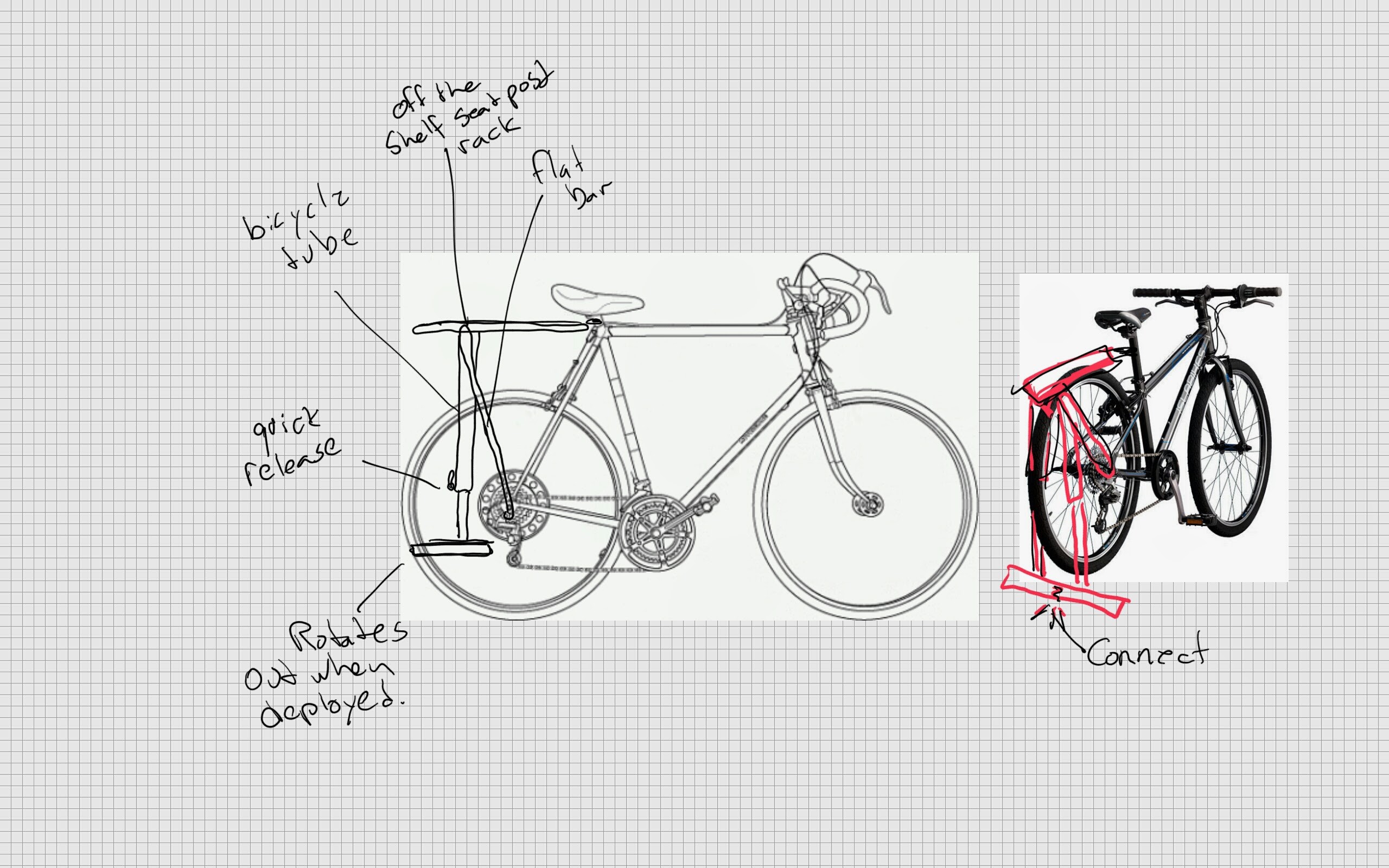
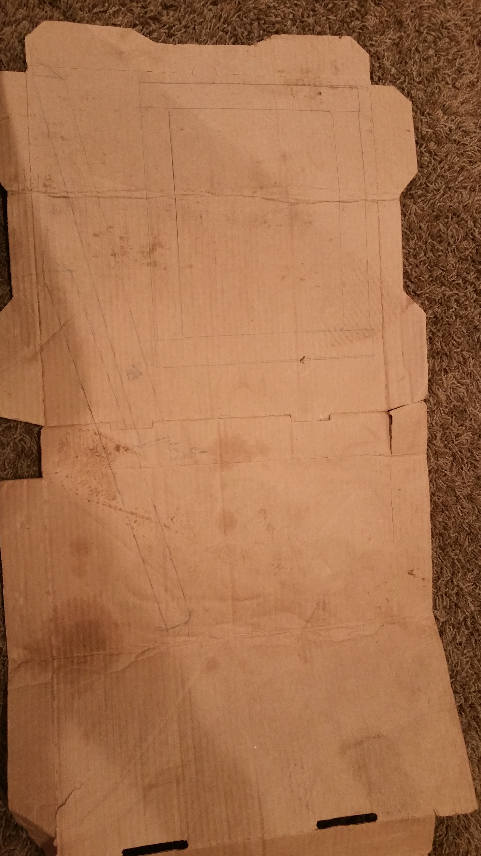
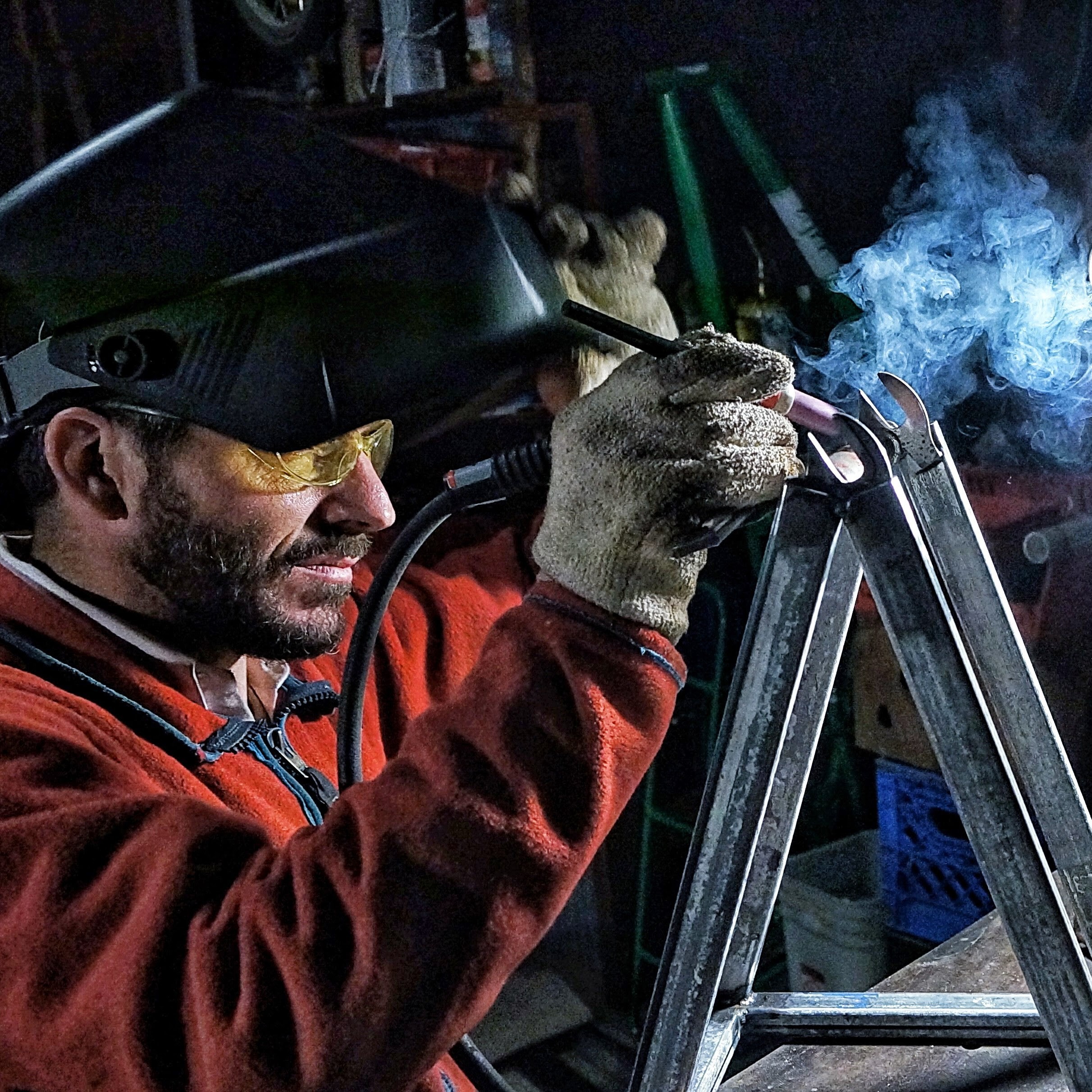
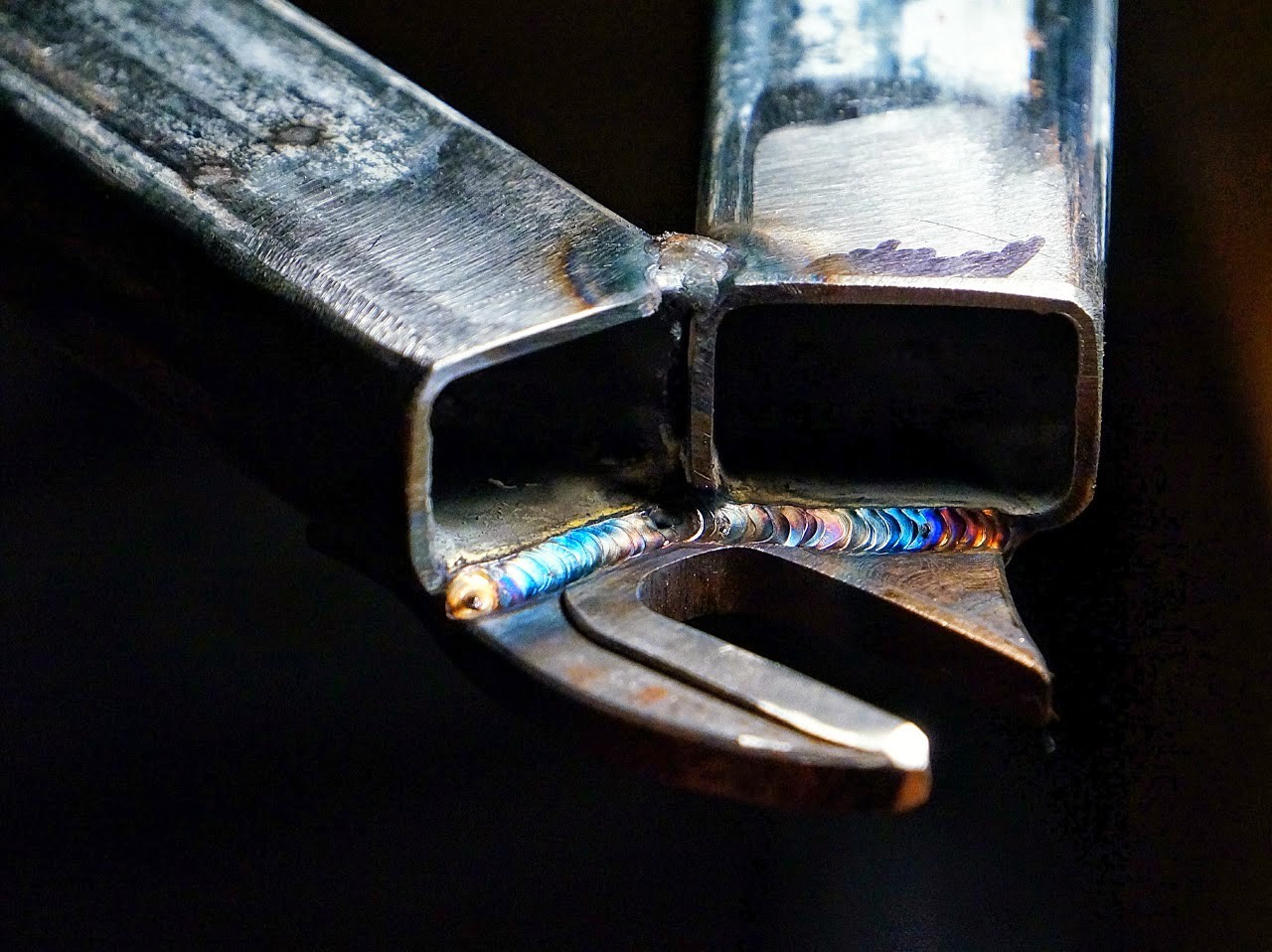
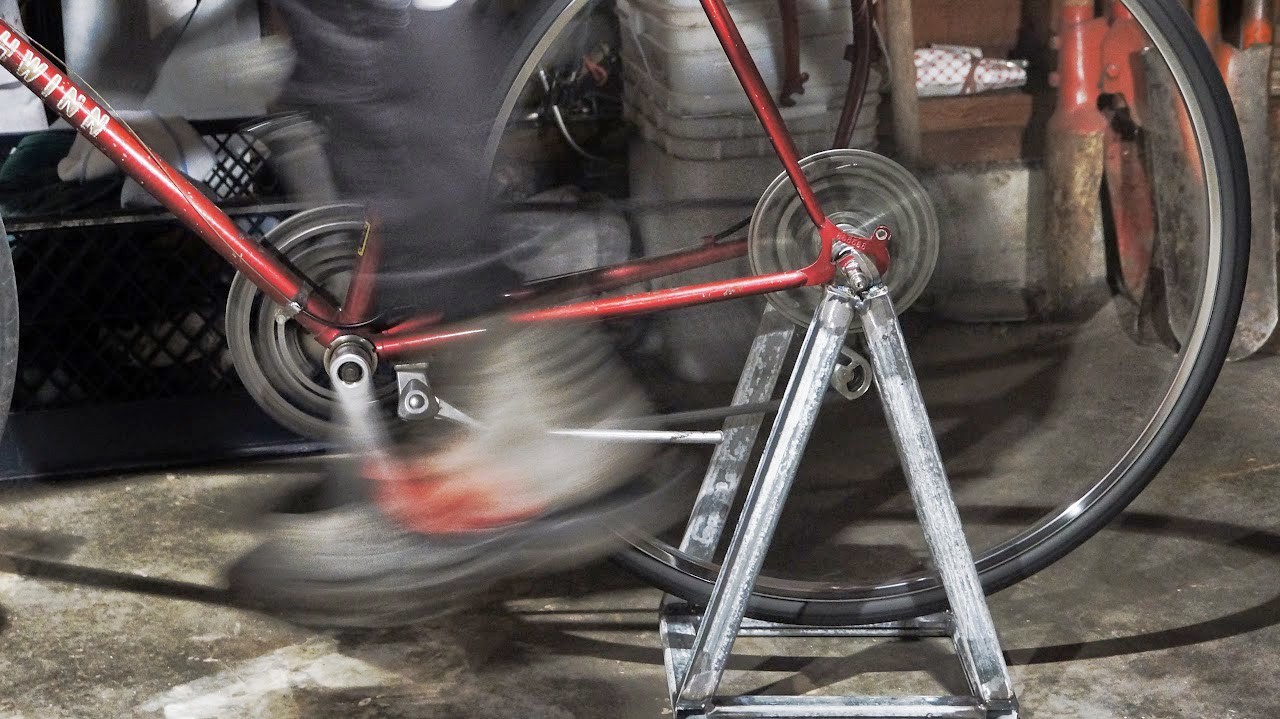
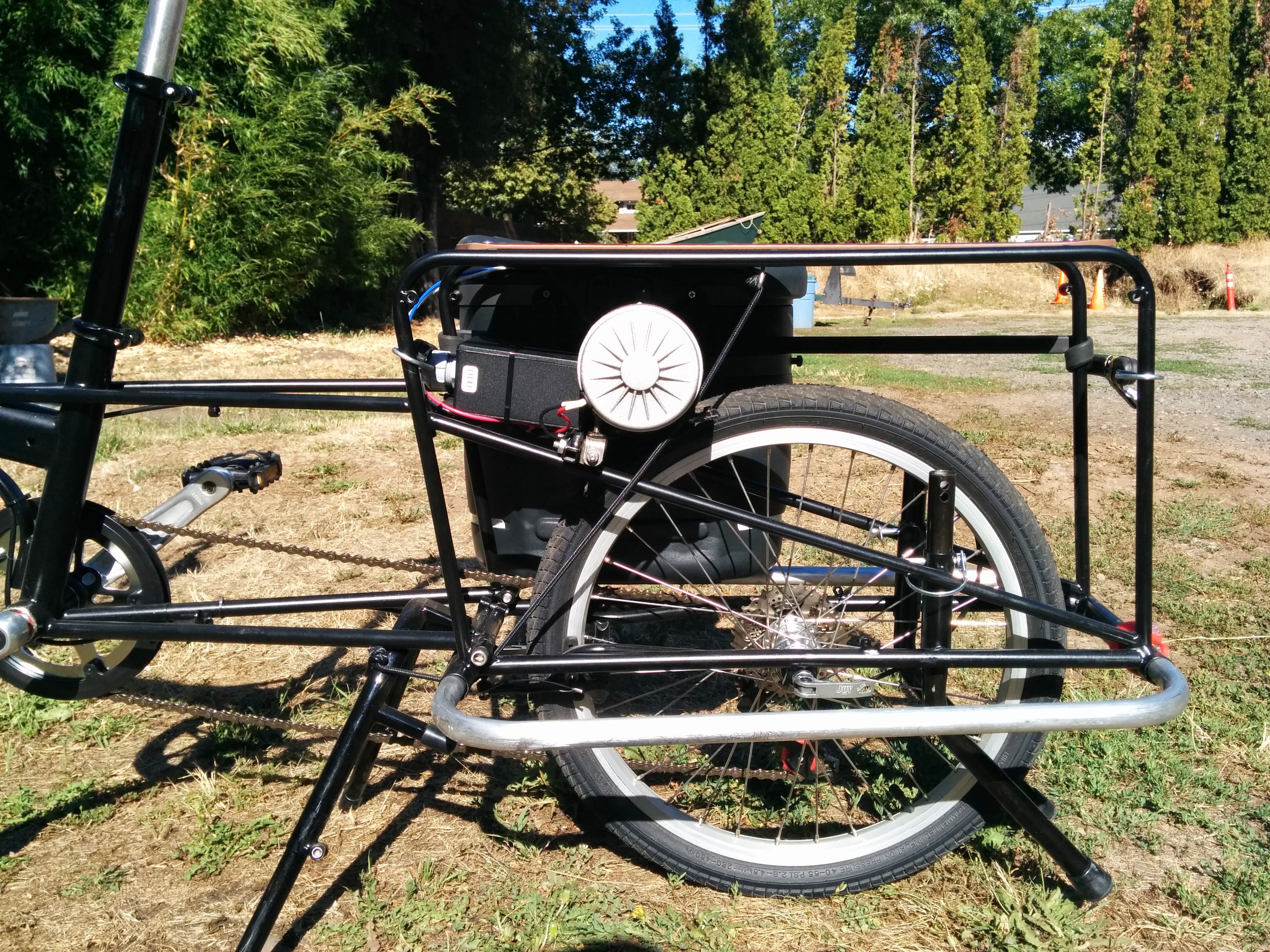
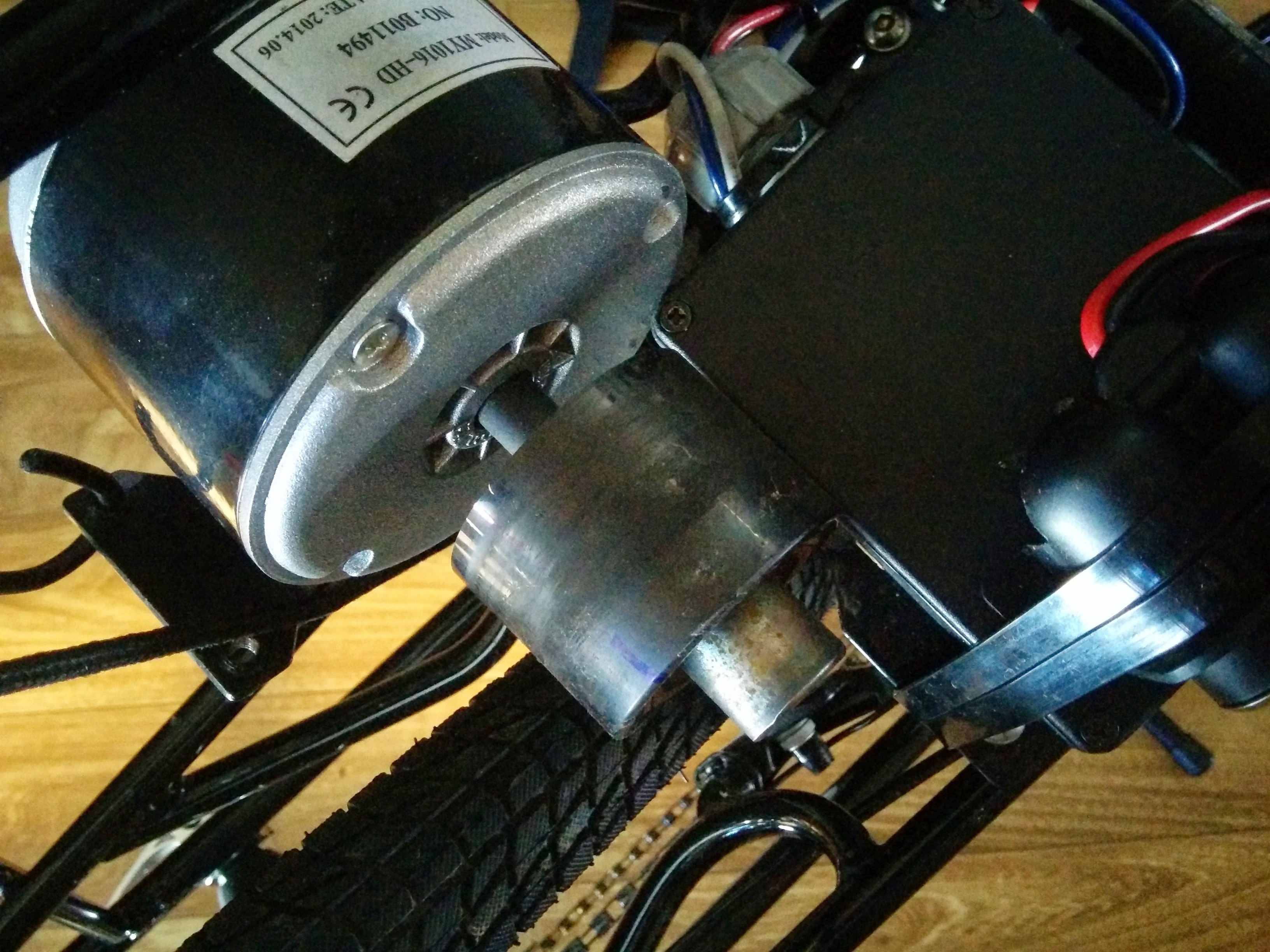
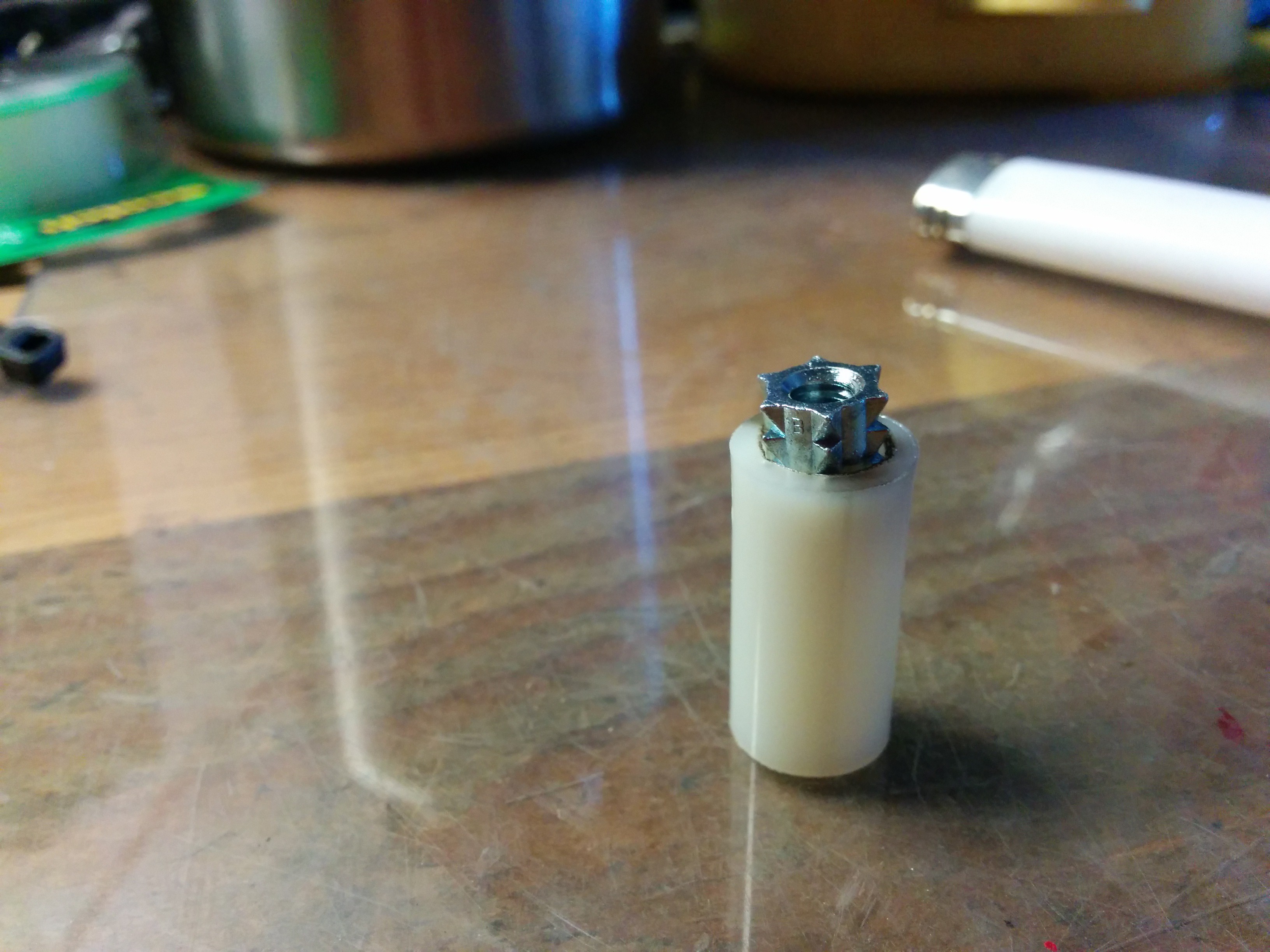 A screw wall anchor is essentially forced into a long vinyl bushing. You need to find an anchor that can't quite fit and then use a lighter to heat up the plastic. Finally, a c-clamp or vice is the best way to force the anchor into the tube.
A screw wall anchor is essentially forced into a long vinyl bushing. You need to find an anchor that can't quite fit and then use a lighter to heat up the plastic. Finally, a c-clamp or vice is the best way to force the anchor into the tube. 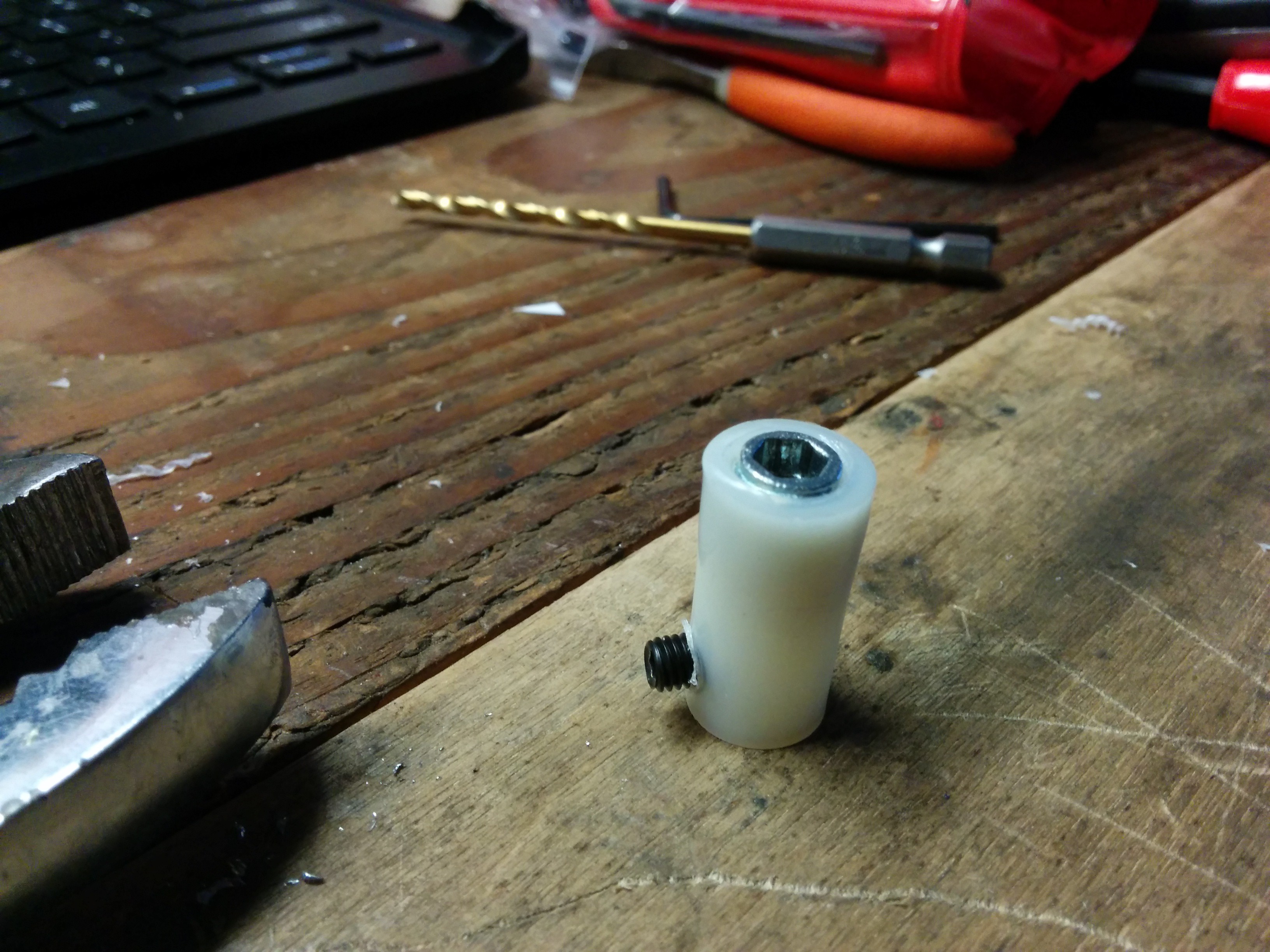 Next drill a hole in the bottom and put a grub screw into it. Drill the hole slightly small that the grub screw so that it threads itself in nicely.
Next drill a hole in the bottom and put a grub screw into it. Drill the hole slightly small that the grub screw so that it threads itself in nicely. 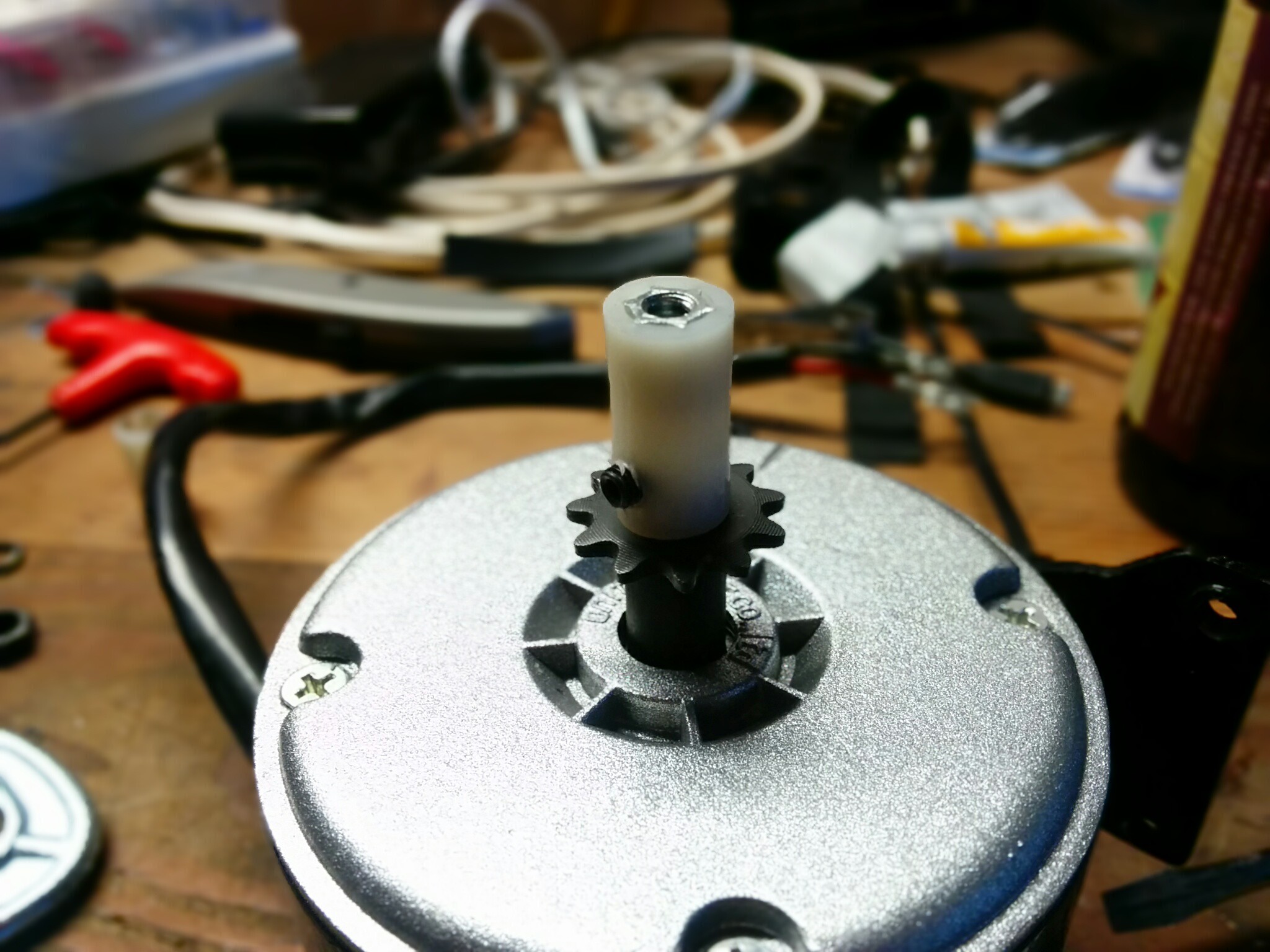 Now you can screw your adapter onto the flat side of the motor shaft using the grub screw to hold it on. Be careful not to over tighten and strip your new threads in the vinyl.
Now you can screw your adapter onto the flat side of the motor shaft using the grub screw to hold it on. Be careful not to over tighten and strip your new threads in the vinyl. 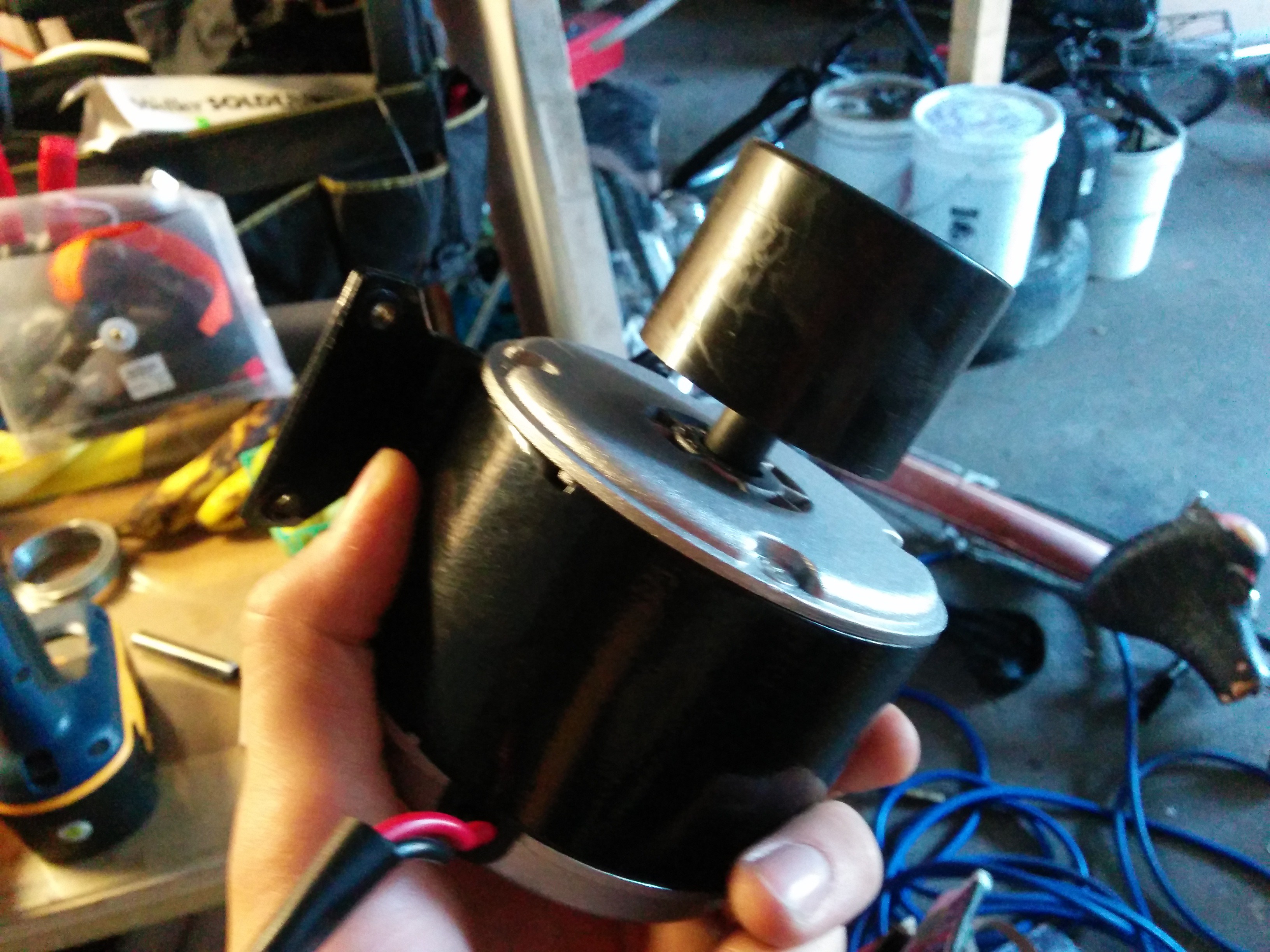
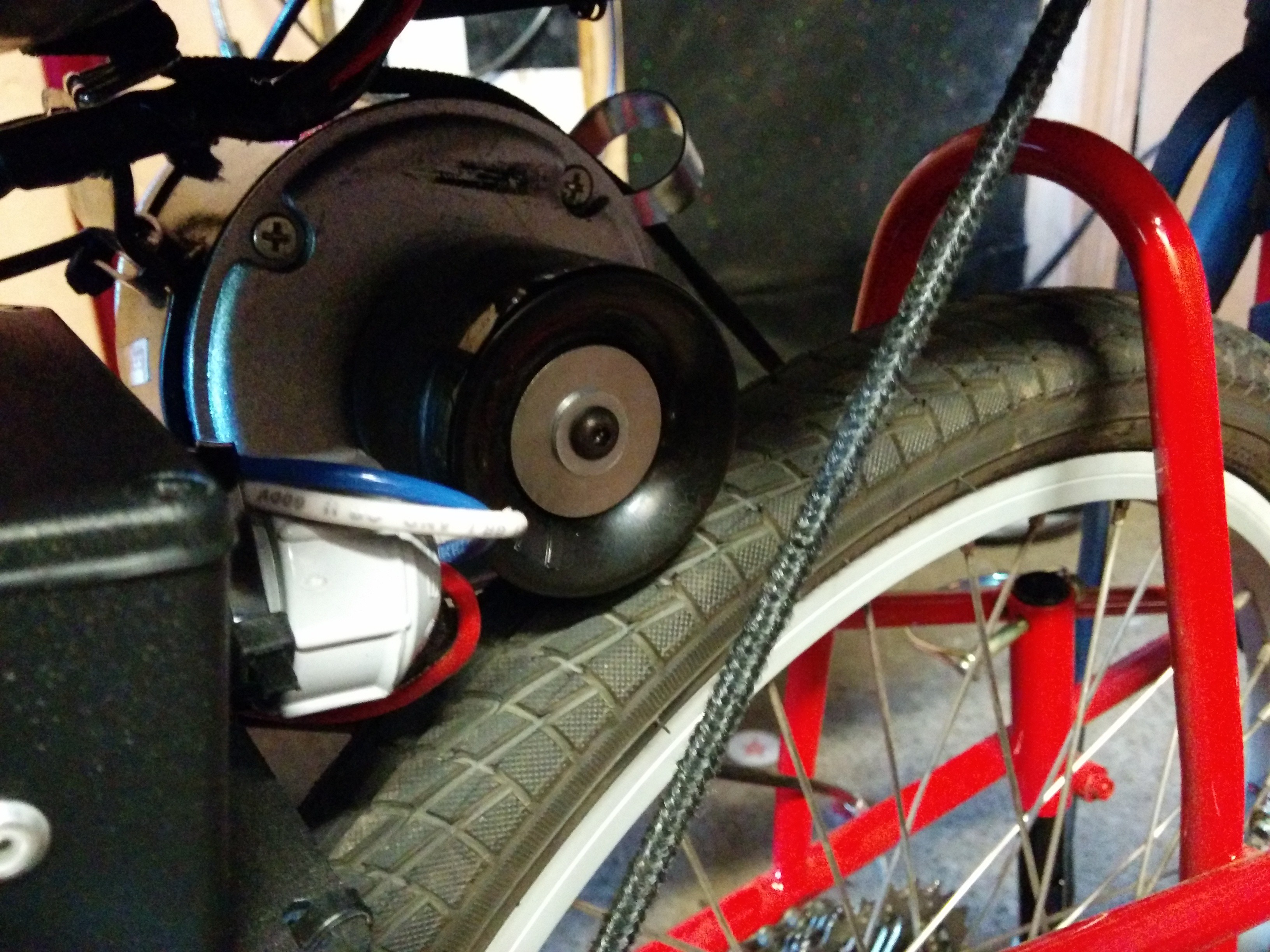 Here it is in action. You can see the multiple washers I had to use to get it to work.
Here it is in action. You can see the multiple washers I had to use to get it to work. 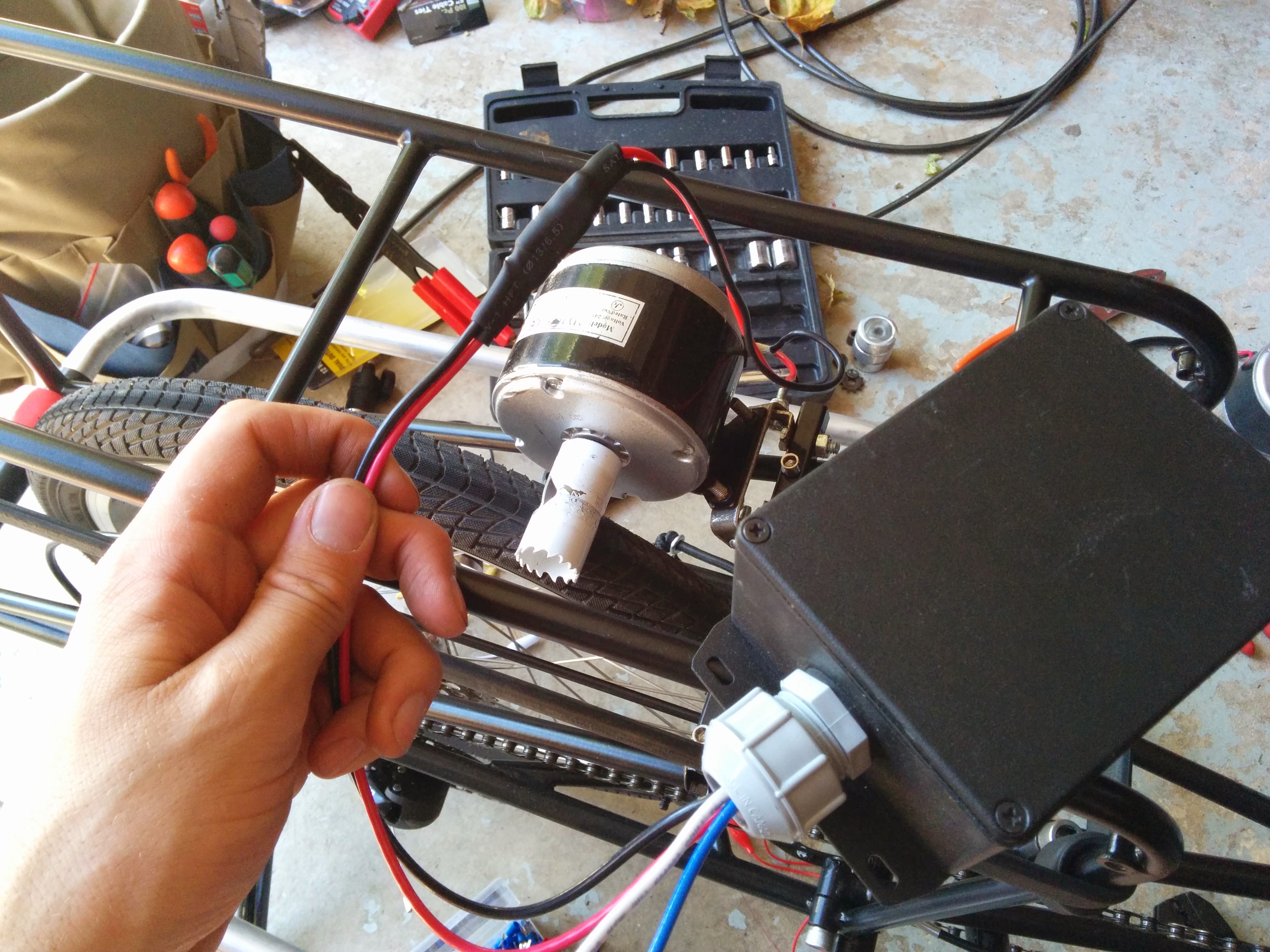
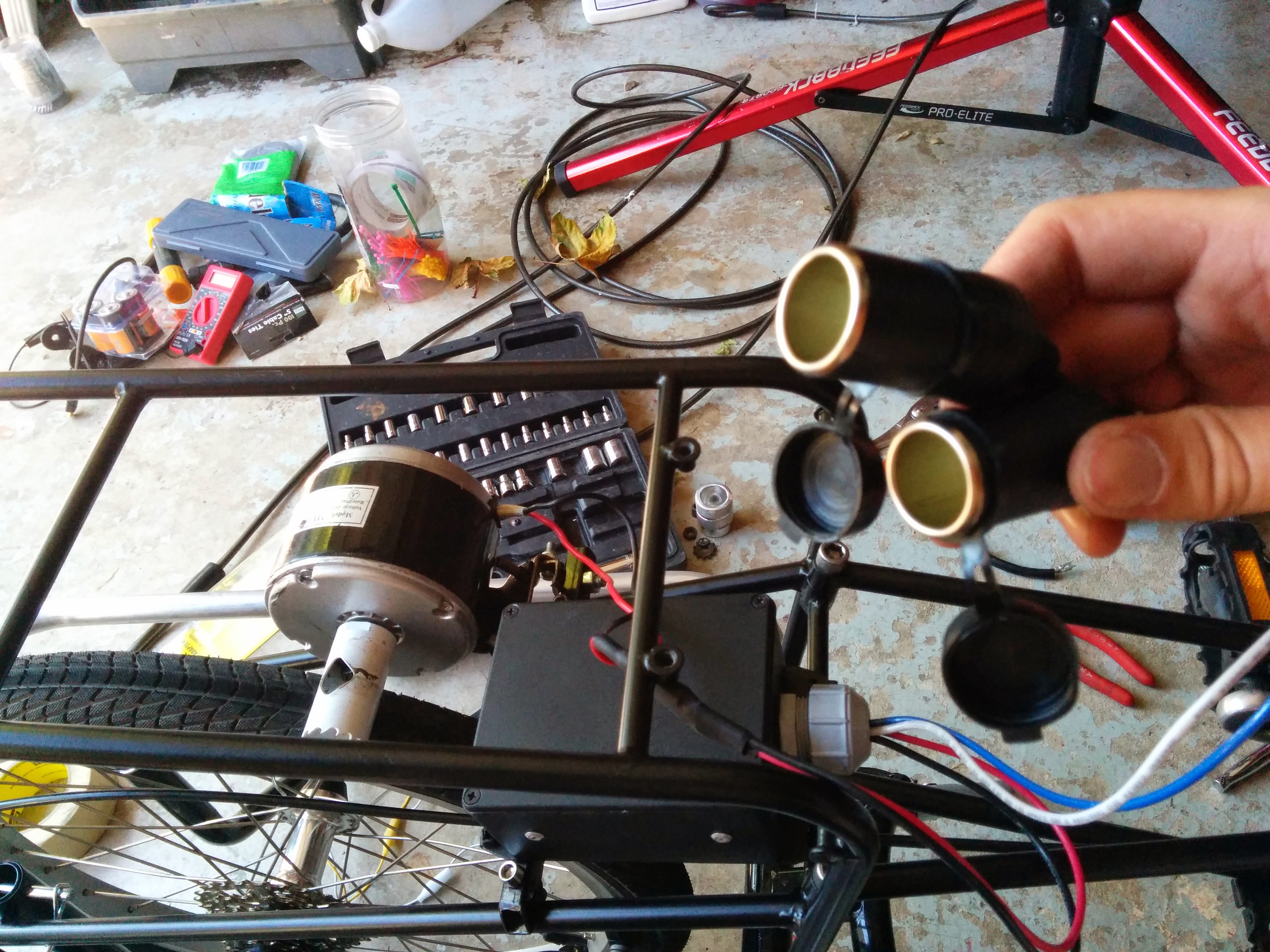 Two 12V ports here coming out of the regulator. They will actually be putting out 14.1V, just above the minimum charge voltage of the Sherpas (14V).
Two 12V ports here coming out of the regulator. They will actually be putting out 14.1V, just above the minimum charge voltage of the Sherpas (14V). 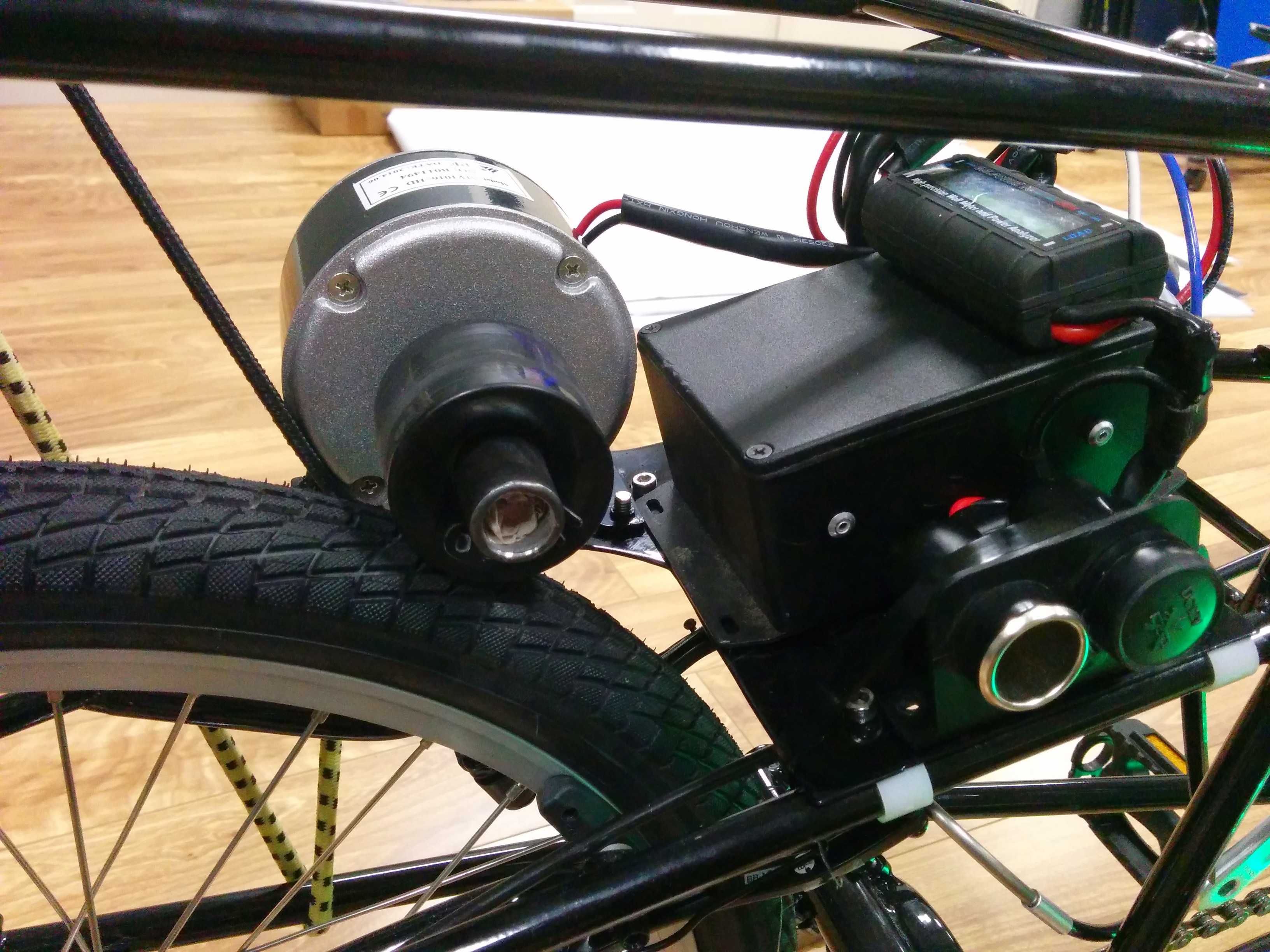
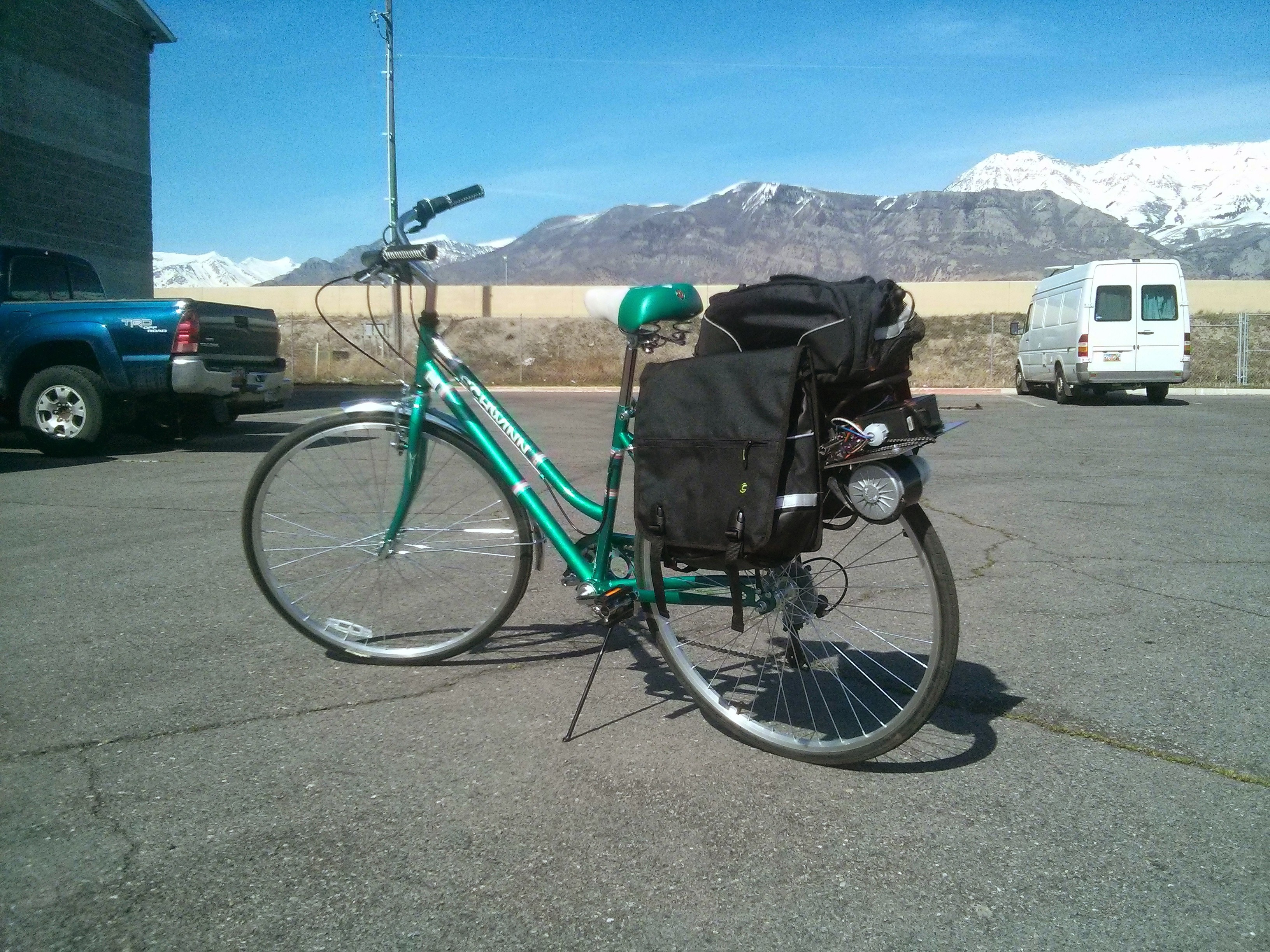


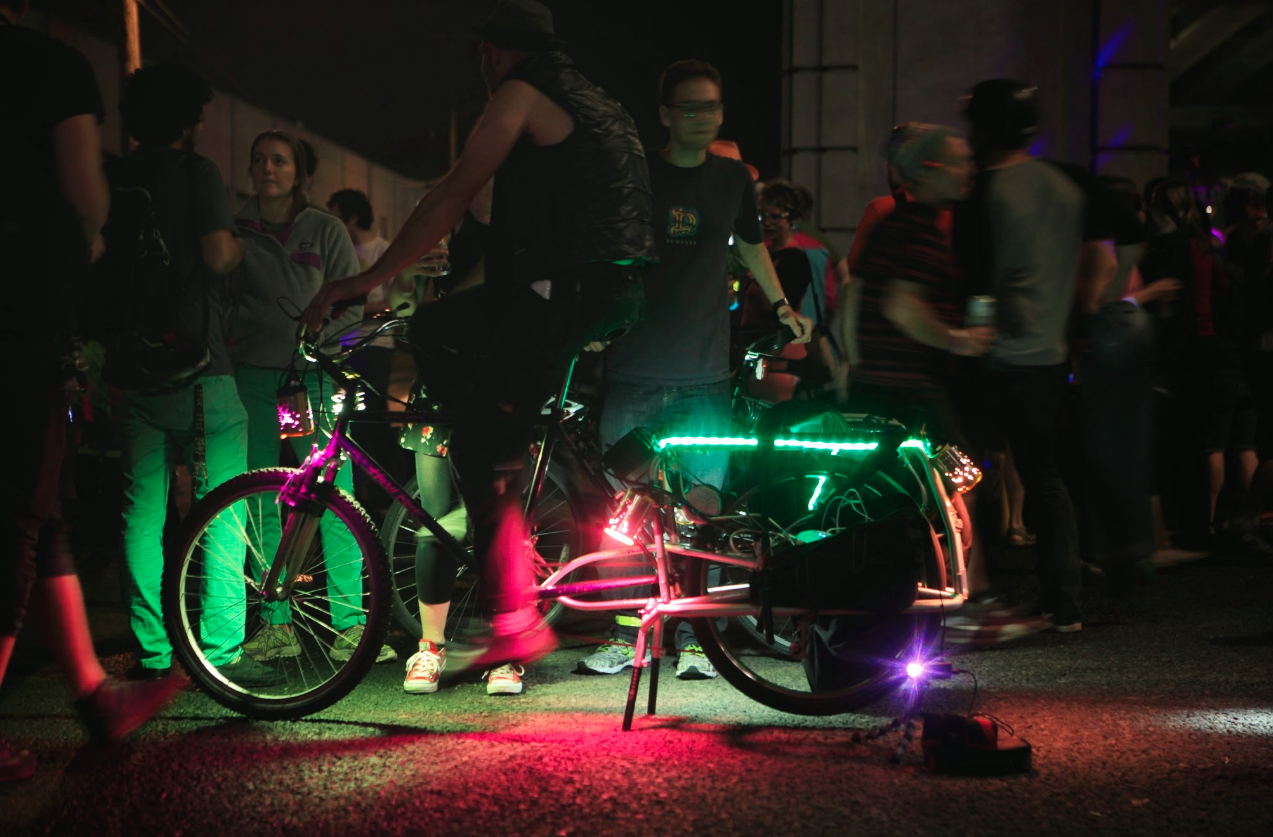
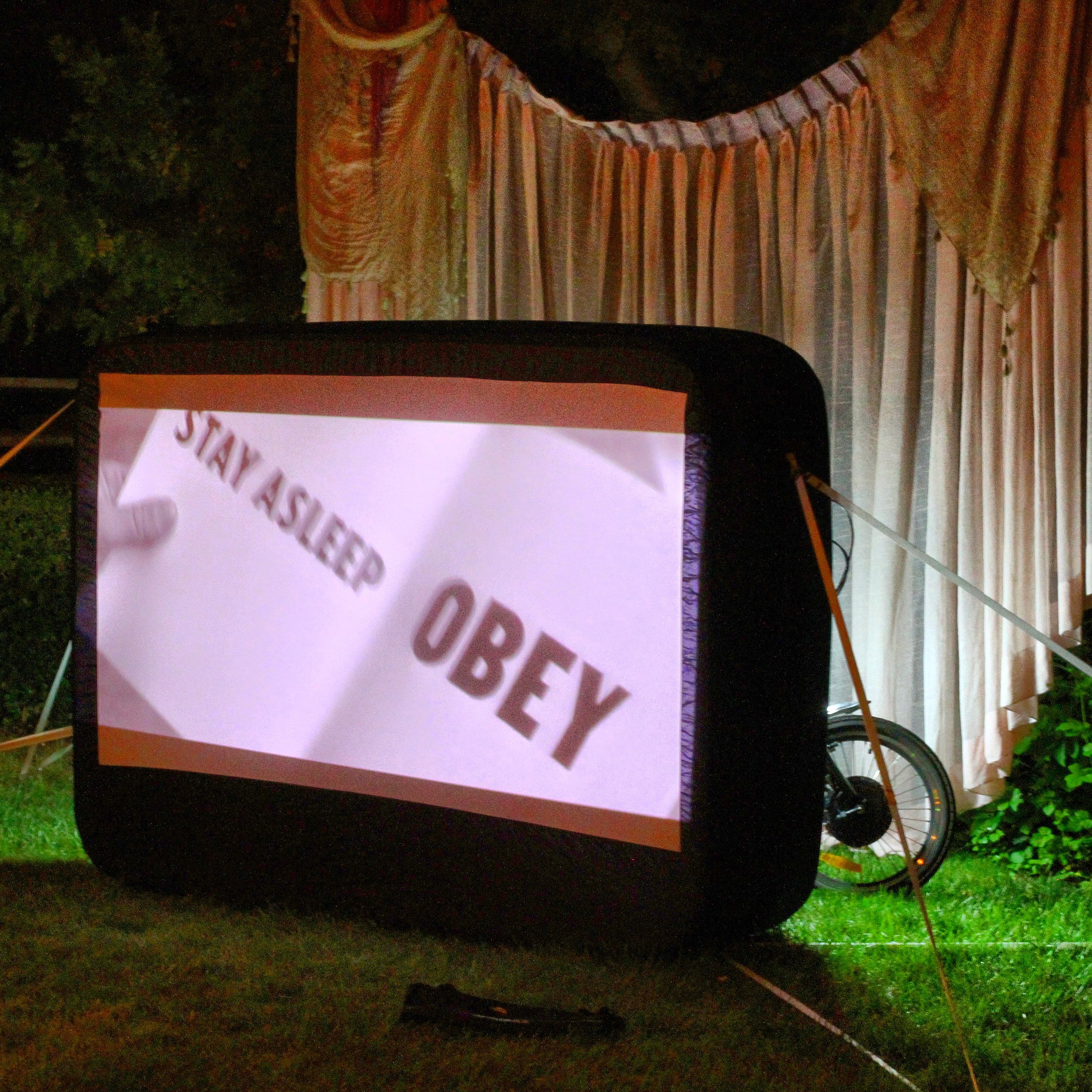
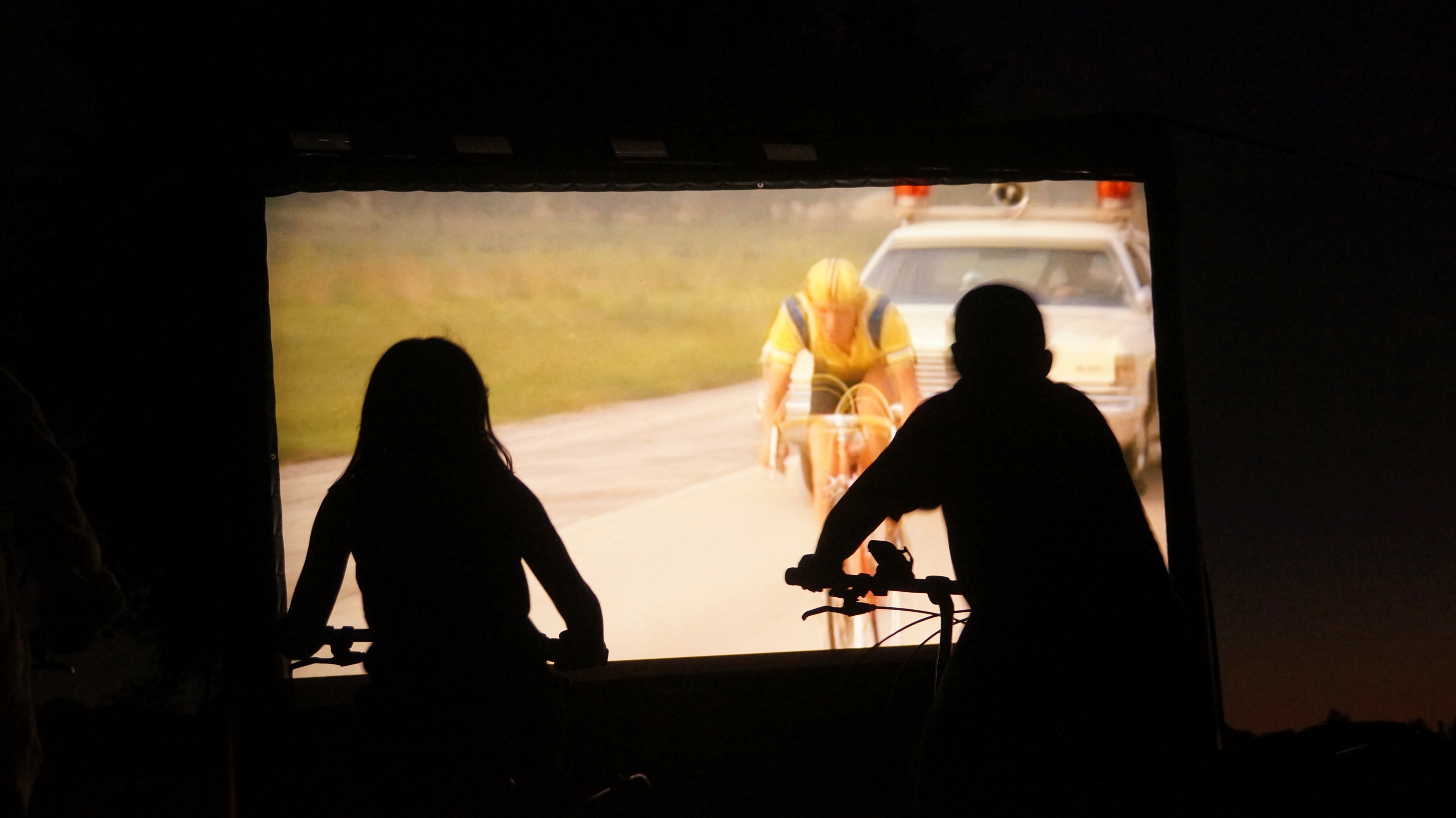
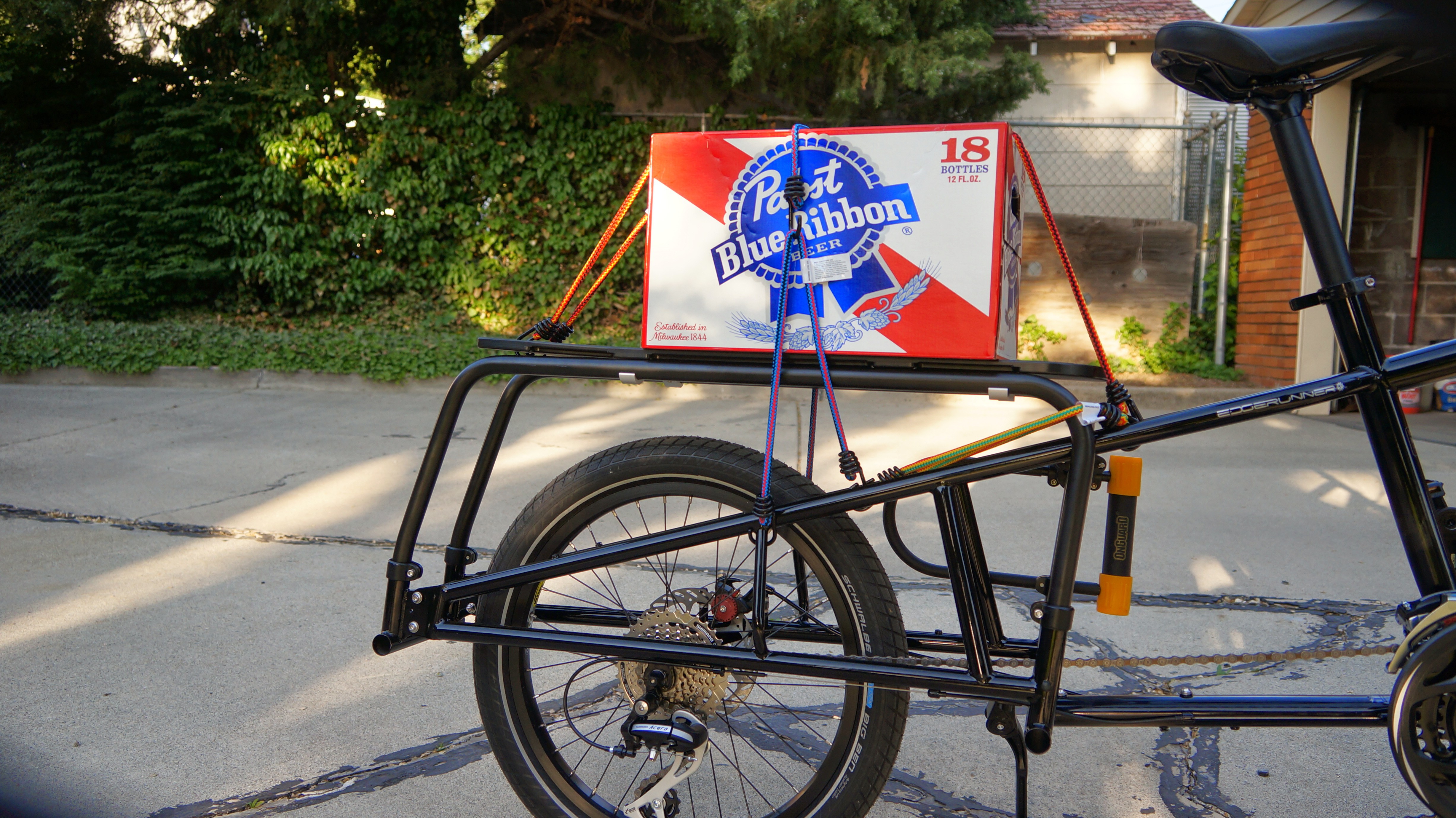
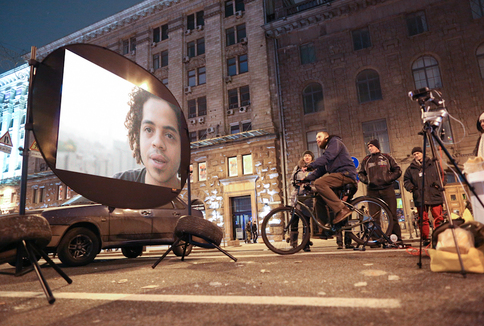
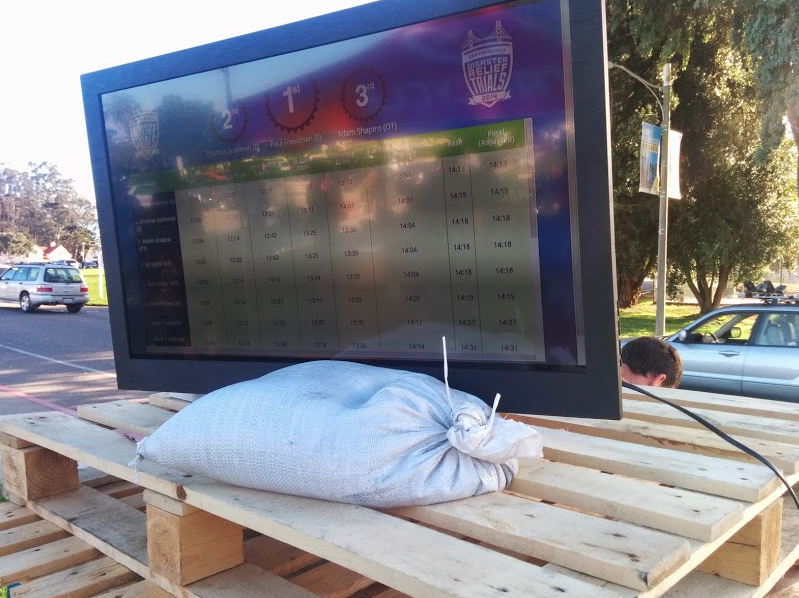
Discussions
Become a Hackaday.io Member
Create an account to leave a comment. Already have an account? Log In.